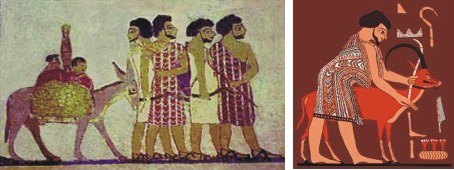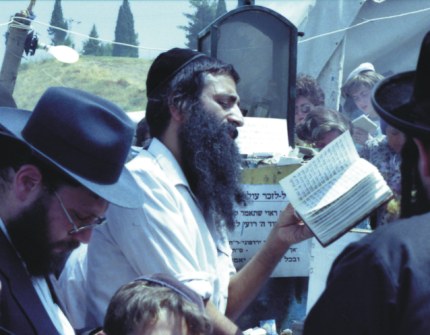Home - Intro - Table of Contents - Hinduism - Buddhism - China - Islam
Christianity - Aaron's Travels/Studies - Bibliography - Index - Bookstore
Judaism really forms the foundation for Christianity and Islam. The historical context of Abraham, Moses, King David and other prophets and leaders must be looked at. Throughout each section, I share personal spiritual experiences. Quotes, photos and charts are from pages 118, and 128-129.
__________________________

The ancient Semitic[2; footnote below] religion and the
establishment of Semitic people in Egypt preceded Moses. What were key elements
within biblical texts that were obviously formulated from oral tradition. What
were the actual records from Egypt and the surrounding environment? Since oral
traditions relied on memories, often passed along many generations after the
said events, details were surely condensed, along with whatever adaptation
suited the current need. Certainly key events might have taken place. Yet how
much were notable figures and events adapted and then adopted into a family or
people’s heritage? Beyond the probability of Abraham being the real name for a
real person, what about the sons of Israel establishing the twelve tribes? What
happened throughout decades of generations when stories were passed along?
Although the power of the stories can transmit spirituality, hope, moral themes,
and practical lessons, the historical context must be examined if we are to
discover what is or might be real.
The earliest mention of Israel within
a historical document occurred on the victory stele of the Pharaoh Merenptah
(1213-1203 BCE), commonly referred to as the “Israeli Stele.” This was the only
mention of the name “Israel” within ancient Egypt. A listing of defeated people
were named in this stele.
" Their chiefs prostrate themselves and beg for peace, Canaan is devastated,
Ashkelon is vanquished, Gezer is taken, Yenoam annihilated, Israel is laid
waste, its seed exists no more, Syria is made a widow for Egypt, and all lands
have been pacified.
Surely the Egyptian pharaoh used elements of self-glorification, nevertheless the name of “Israel” was mentioned. In contrast to the historical document, the biblical account stated an opposite viewpoint of destruction.
"So Pharaoh had his chariot harnessed and gathered his troops about him,
taking six hundred of the best chariots and all the other chariots in Egypt ...
Moses stretched out his hand over the sea. Yahweh drove back the sea with a
strong easterly wind all night, and he made dry land of the sea. The waters
parted and the sons of Israel went on dry ground right into the sea, walls of
water to right and to left of them. ... Moses stretched out his hand over the
sea and as day broke, the sea returned to its bed. The fleeing Egyptians marched
right into it, and Yahweh overthrew the chariots and the horsemen of Pharaoh’s
whole army, which had followed the Israelites into the sea; not a single one of
them was left."
(Exodus 14:6-7, 21-22, 27-29)
When comparing these two accounts, the Egyptian stele dated from the same generation the events were said to have occurred. The miracle of dividing the sea from the Moses account was probably recorded hundreds of years after its said occurrence. When a group of people referred to as Hebrews attempted to establish themselves, oral traditions were likely embellished and exaggerated (many groups do this: Homer would write an epic for the Greeks, Virgil for the Romans, et cetera). Fortunately, Egypt contains a wealth of archeological evidence to interpret what might have happened.[3; footnote below]
[footnote 2 As a linguistic group, the ancient Semites could be
said to have occupied West Asia. This included Assyrians and Babylonians around
the Tigris and Euphrates rivers. I am using the narrower sense for Semites to
include those people such as Canaanites and others in and around Palestine where
Abraham was said to have established his family.
footnote 3 To determine
the historical accuracy of Egyptian accounts during the general time frame of
the Israeli Stele, a foreign war was described in detail by Merenptah’s Father,
Rameses II. Here 20,000 Egyptian troops marched up the coast of the
Mediterranean through Canaan to Syria for the famous Battle of Qadesh in about
1274 BCE. The resulting peace treaty with the Hittites was accurately recorded,
both on the cuneiform tablets of the Hittites and Egyptian monuments. Also,
Egyptians had constant access to the Sinai. Throughout almost every established
dynasty, Egyptians controlled much of the land in and around Palestine. Egyptian
mines in the Sinai were usually well protected.]
__________________________
[The section on Israel traces every known historical document and
some archaeological evidence of early Israel. It is interesting to note that
Moses was a somewhat common name in Egypt during the approximate time the Jewish
Moses was said to live. I even show the name Moses (Mosis or Moshe) in Egyptian
Hieroglyphs and Hebrew. I highlight elements of ancient Egyptian scripture and
detail the Monotheistic religious revolution by the Pharaoh Akhenaten.
Within other chapters I share fundamental elements of being a practicing Jew. Read the morning blessing of the Siddur, the Daily Prayer Book. When in Israel I studied with the orthodox Hasidic Jews in Safed. Portions of my book even contain journal entries, as shared in the next quote.]

7-27-90 (from my journal, a few hours before I took the photo
above)
The anniversary of Ari’s (the Ari refers to Isaac Luria who lived
from 1534-1572 CE and was a prominent teacher of the Kabbalah, Jewish mysticism)
death permeates Safed. A literal blanket of fog seems to move through the area.
This atmosphere is mystically real. The Jews form a wondrous mode of
interacting. Their connection with God proves worthy and if properly attached,
then dependable. The world functions through blessings. This fog seems to work
in conjunction with the birth day of Ari’s death.
Many Jews here have a
strong connection to Ari since he formed a powerful connection with God,
especially in the transcendent aspects. Through this bond, Moses becomes more
alive within the context of time. These are revolutions of similarity, just as
the earth orbits the sun. Humans may count the years, yet the orbits remain
primarily the same. Yes, the spiritual power of some souls seems to complete the
orbit where God shines within the center. Time begins with life on earth, until
it ends with life in earth. All the orbits follow the same circle, the same
track. As the earth forms a circle around the sun, a beam of light reflects the
sun. When stopping this framework (the orbit) to see how a beam of light looks,
a day and night emerge. A combination of beams within the lifetime can manifest
the power of God.
Today as the veil of fog lifts I connect to the power
of God through the life or Ari, and through the life of Moses ...
[Read continuing journal entries and more.]
__________________________
Home - Intro - Table of Contents - Hinduism - Buddhism - China - Islam
Christianity - Aaron's Travels/Studies - Bibliography - Index - Bookstore